Financial Accounting Principles and Techniques
VerifiedAdded on 2023/01/12
|18
|3481
|25
AI Summary
This project report covers essential financial accounting principles and techniques. It includes topics like trial balance, ledger, and financial statements. The tasks cover recording business transactions, preparing final accounts, bank reconciliations, and control accounts.
Contribute Materials
Your contribution can guide someone’s learning journey. Share your
documents today.
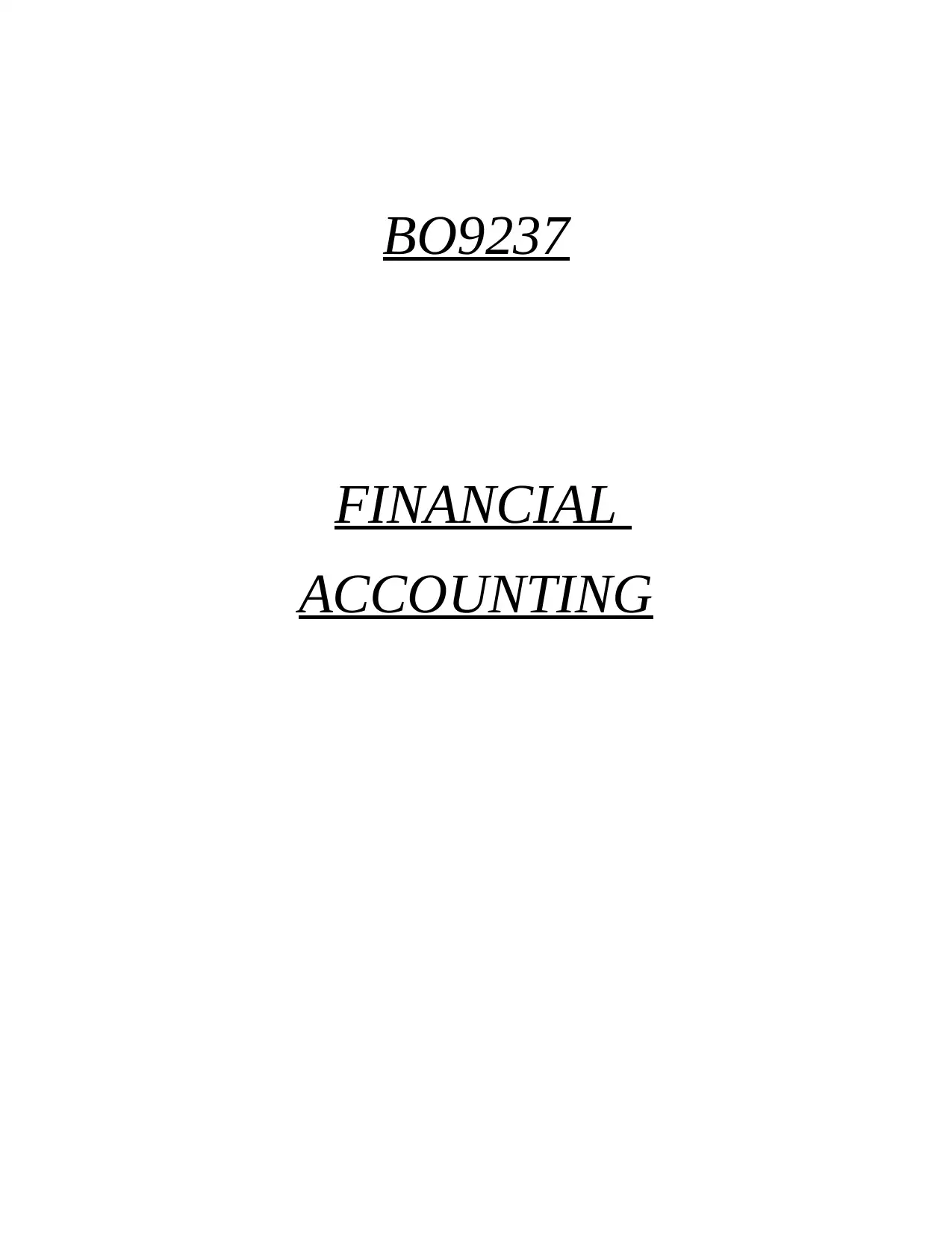
BO9237
FINANCIAL
ACCOUNTING
FINANCIAL
ACCOUNTING
Secure Best Marks with AI Grader
Need help grading? Try our AI Grader for instant feedback on your assignments.
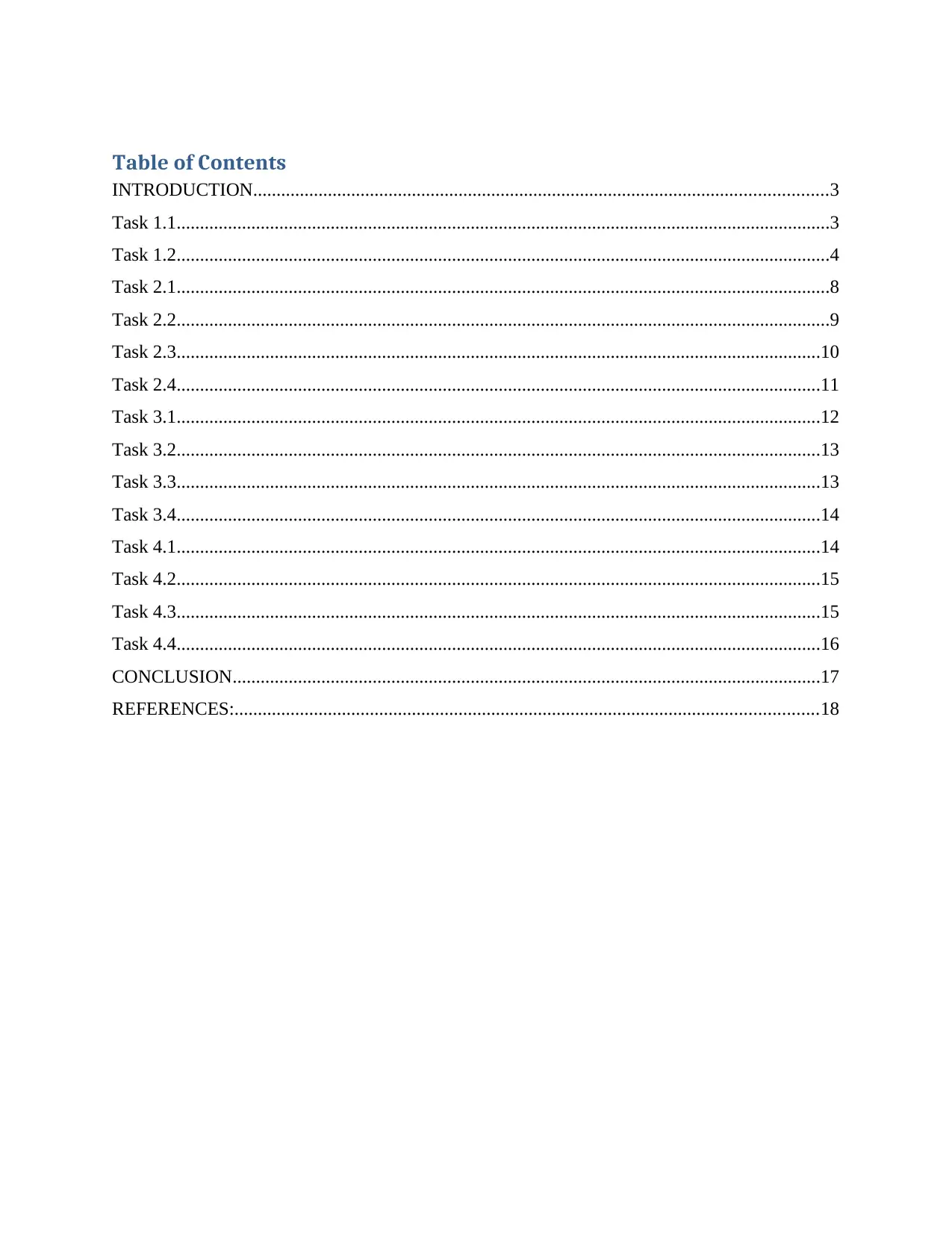
Table of Contents
INTRODUCTION...........................................................................................................................3
Task 1.1............................................................................................................................................3
Task 1.2............................................................................................................................................4
Task 2.1............................................................................................................................................8
Task 2.2............................................................................................................................................9
Task 2.3..........................................................................................................................................10
Task 2.4..........................................................................................................................................11
Task 3.1..........................................................................................................................................12
Task 3.2..........................................................................................................................................13
Task 3.3..........................................................................................................................................13
Task 3.4..........................................................................................................................................14
Task 4.1..........................................................................................................................................14
Task 4.2..........................................................................................................................................15
Task 4.3..........................................................................................................................................15
Task 4.4..........................................................................................................................................16
CONCLUSION..............................................................................................................................17
REFERENCES:.............................................................................................................................18
INTRODUCTION...........................................................................................................................3
Task 1.1............................................................................................................................................3
Task 1.2............................................................................................................................................4
Task 2.1............................................................................................................................................8
Task 2.2............................................................................................................................................9
Task 2.3..........................................................................................................................................10
Task 2.4..........................................................................................................................................11
Task 3.1..........................................................................................................................................12
Task 3.2..........................................................................................................................................13
Task 3.3..........................................................................................................................................13
Task 3.4..........................................................................................................................................14
Task 4.1..........................................................................................................................................14
Task 4.2..........................................................................................................................................15
Task 4.3..........................................................................................................................................15
Task 4.4..........................................................................................................................................16
CONCLUSION..............................................................................................................................17
REFERENCES:.............................................................................................................................18
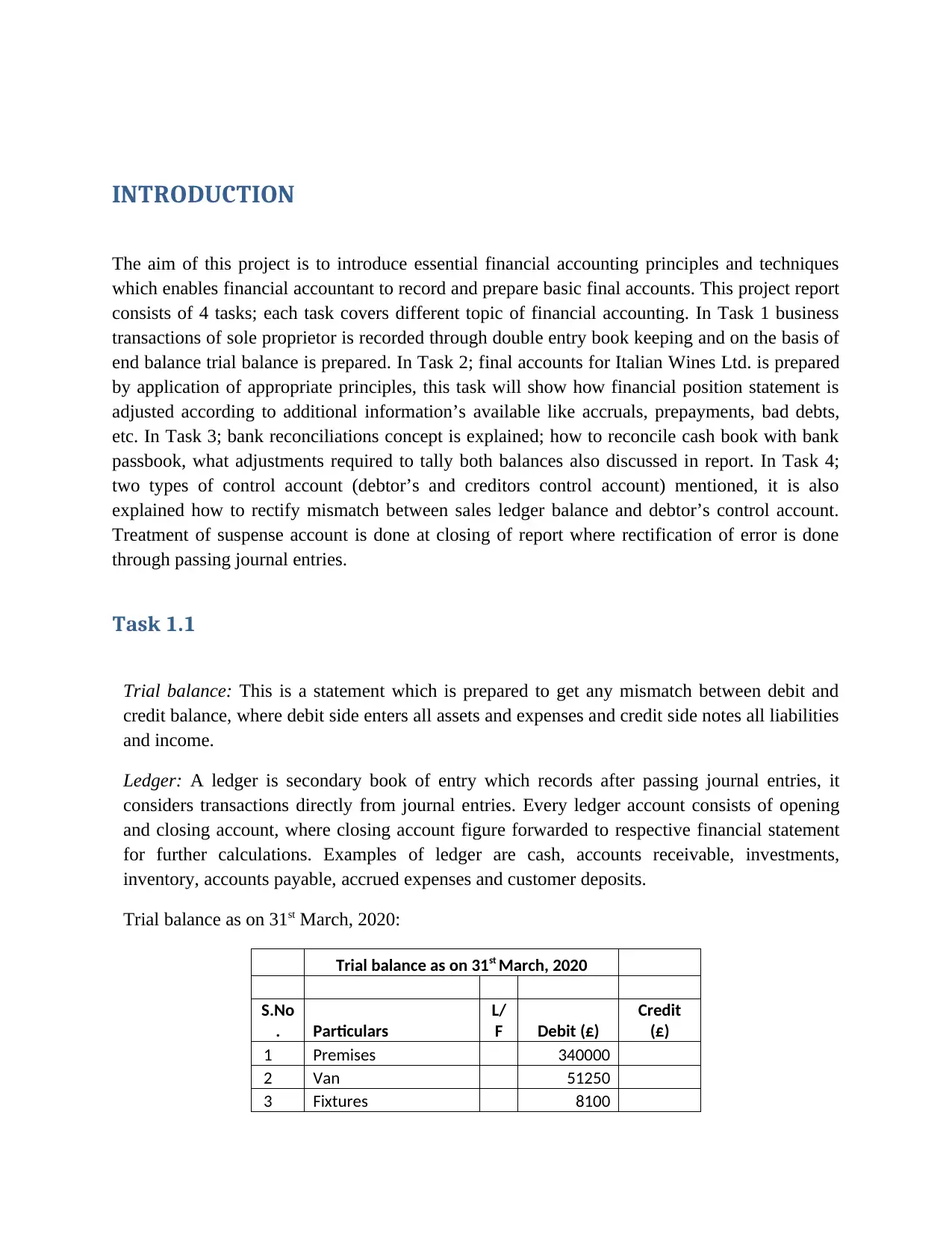
INTRODUCTION
The aim of this project is to introduce essential financial accounting principles and techniques
which enables financial accountant to record and prepare basic final accounts. This project report
consists of 4 tasks; each task covers different topic of financial accounting. In Task 1 business
transactions of sole proprietor is recorded through double entry book keeping and on the basis of
end balance trial balance is prepared. In Task 2; final accounts for Italian Wines Ltd. is prepared
by application of appropriate principles, this task will show how financial position statement is
adjusted according to additional information’s available like accruals, prepayments, bad debts,
etc. In Task 3; bank reconciliations concept is explained; how to reconcile cash book with bank
passbook, what adjustments required to tally both balances also discussed in report. In Task 4;
two types of control account (debtor’s and creditors control account) mentioned, it is also
explained how to rectify mismatch between sales ledger balance and debtor’s control account.
Treatment of suspense account is done at closing of report where rectification of error is done
through passing journal entries.
Task 1.1
Trial balance: This is a statement which is prepared to get any mismatch between debit and
credit balance, where debit side enters all assets and expenses and credit side notes all liabilities
and income.
Ledger: A ledger is secondary book of entry which records after passing journal entries, it
considers transactions directly from journal entries. Every ledger account consists of opening
and closing account, where closing account figure forwarded to respective financial statement
for further calculations. Examples of ledger are cash, accounts receivable, investments,
inventory, accounts payable, accrued expenses and customer deposits.
Trial balance as on 31st March, 2020:
Trial balance as on 31st March, 2020
S.No
. Particulars
L/
F Debit (£)
Credit
(£)
1 Premises 340000
2 Van 51250
3 Fixtures 8100
The aim of this project is to introduce essential financial accounting principles and techniques
which enables financial accountant to record and prepare basic final accounts. This project report
consists of 4 tasks; each task covers different topic of financial accounting. In Task 1 business
transactions of sole proprietor is recorded through double entry book keeping and on the basis of
end balance trial balance is prepared. In Task 2; final accounts for Italian Wines Ltd. is prepared
by application of appropriate principles, this task will show how financial position statement is
adjusted according to additional information’s available like accruals, prepayments, bad debts,
etc. In Task 3; bank reconciliations concept is explained; how to reconcile cash book with bank
passbook, what adjustments required to tally both balances also discussed in report. In Task 4;
two types of control account (debtor’s and creditors control account) mentioned, it is also
explained how to rectify mismatch between sales ledger balance and debtor’s control account.
Treatment of suspense account is done at closing of report where rectification of error is done
through passing journal entries.
Task 1.1
Trial balance: This is a statement which is prepared to get any mismatch between debit and
credit balance, where debit side enters all assets and expenses and credit side notes all liabilities
and income.
Ledger: A ledger is secondary book of entry which records after passing journal entries, it
considers transactions directly from journal entries. Every ledger account consists of opening
and closing account, where closing account figure forwarded to respective financial statement
for further calculations. Examples of ledger are cash, accounts receivable, investments,
inventory, accounts payable, accrued expenses and customer deposits.
Trial balance as on 31st March, 2020:
Trial balance as on 31st March, 2020
S.No
. Particulars
L/
F Debit (£)
Credit
(£)
1 Premises 340000
2 Van 51250
3 Fixtures 8100
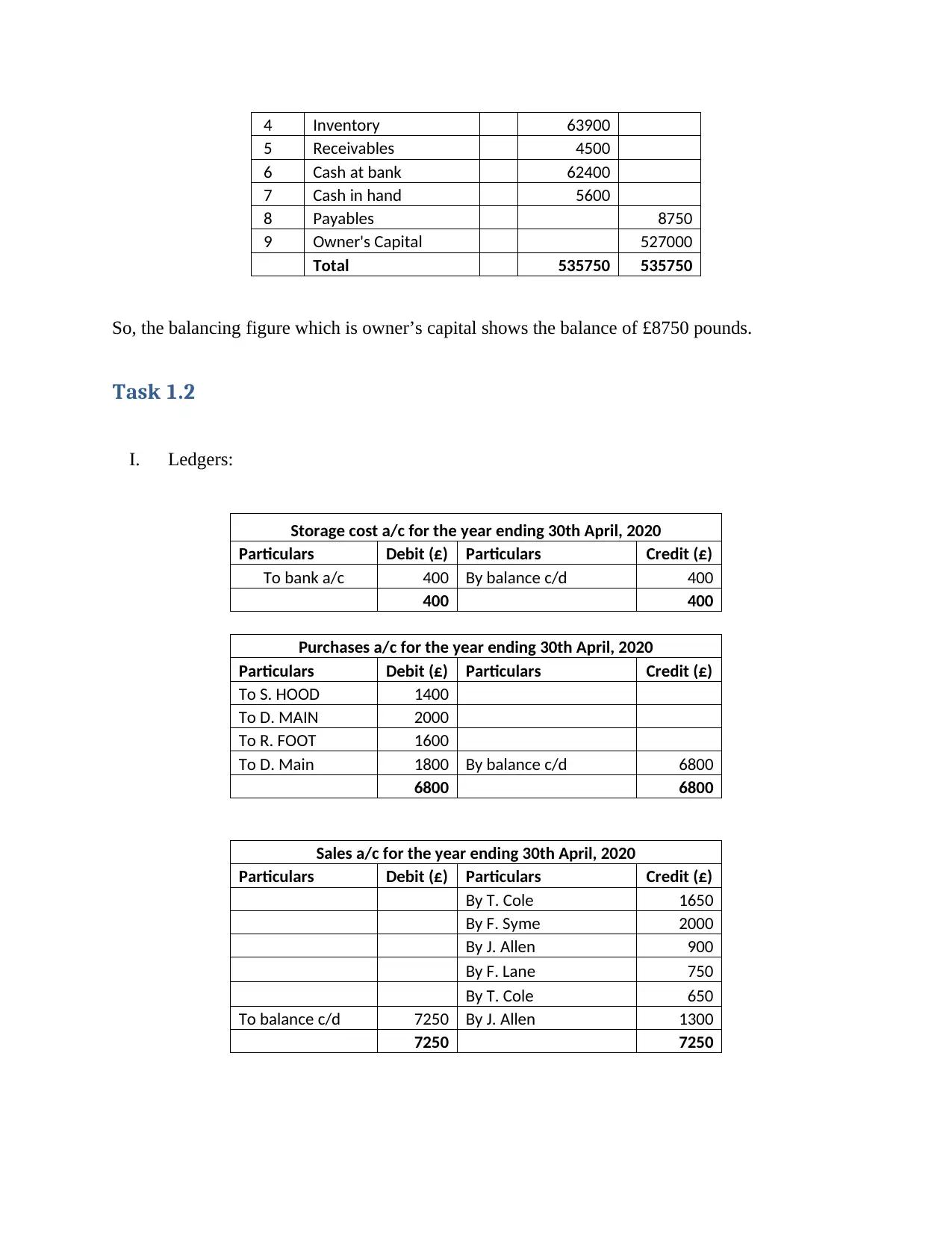
4 Inventory 63900
5 Receivables 4500
6 Cash at bank 62400
7 Cash in hand 5600
8 Payables 8750
9 Owner's Capital 527000
Total 535750 535750
So, the balancing figure which is owner’s capital shows the balance of £8750 pounds.
Task 1.2
I. Ledgers:
Storage cost a/c for the year ending 30th April, 2020
Particulars Debit (£) Particulars Credit (£)
To bank a/c 400 By balance c/d 400
400 400
Purchases a/c for the year ending 30th April, 2020
Particulars Debit (£) Particulars Credit (£)
To S. HOOD 1400
To D. MAIN 2000
To R. FOOT 1600
To D. Main 1800 By balance c/d 6800
6800 6800
Sales a/c for the year ending 30th April, 2020
Particulars Debit (£) Particulars Credit (£)
By T. Cole 1650
By F. Syme 2000
By J. Allen 900
By F. Lane 750
By T. Cole 650
To balance c/d 7250 By J. Allen 1300
7250 7250
5 Receivables 4500
6 Cash at bank 62400
7 Cash in hand 5600
8 Payables 8750
9 Owner's Capital 527000
Total 535750 535750
So, the balancing figure which is owner’s capital shows the balance of £8750 pounds.
Task 1.2
I. Ledgers:
Storage cost a/c for the year ending 30th April, 2020
Particulars Debit (£) Particulars Credit (£)
To bank a/c 400 By balance c/d 400
400 400
Purchases a/c for the year ending 30th April, 2020
Particulars Debit (£) Particulars Credit (£)
To S. HOOD 1400
To D. MAIN 2000
To R. FOOT 1600
To D. Main 1800 By balance c/d 6800
6800 6800
Sales a/c for the year ending 30th April, 2020
Particulars Debit (£) Particulars Credit (£)
By T. Cole 1650
By F. Syme 2000
By J. Allen 900
By F. Lane 750
By T. Cole 650
To balance c/d 7250 By J. Allen 1300
7250 7250
Secure Best Marks with AI Grader
Need help grading? Try our AI Grader for instant feedback on your assignments.
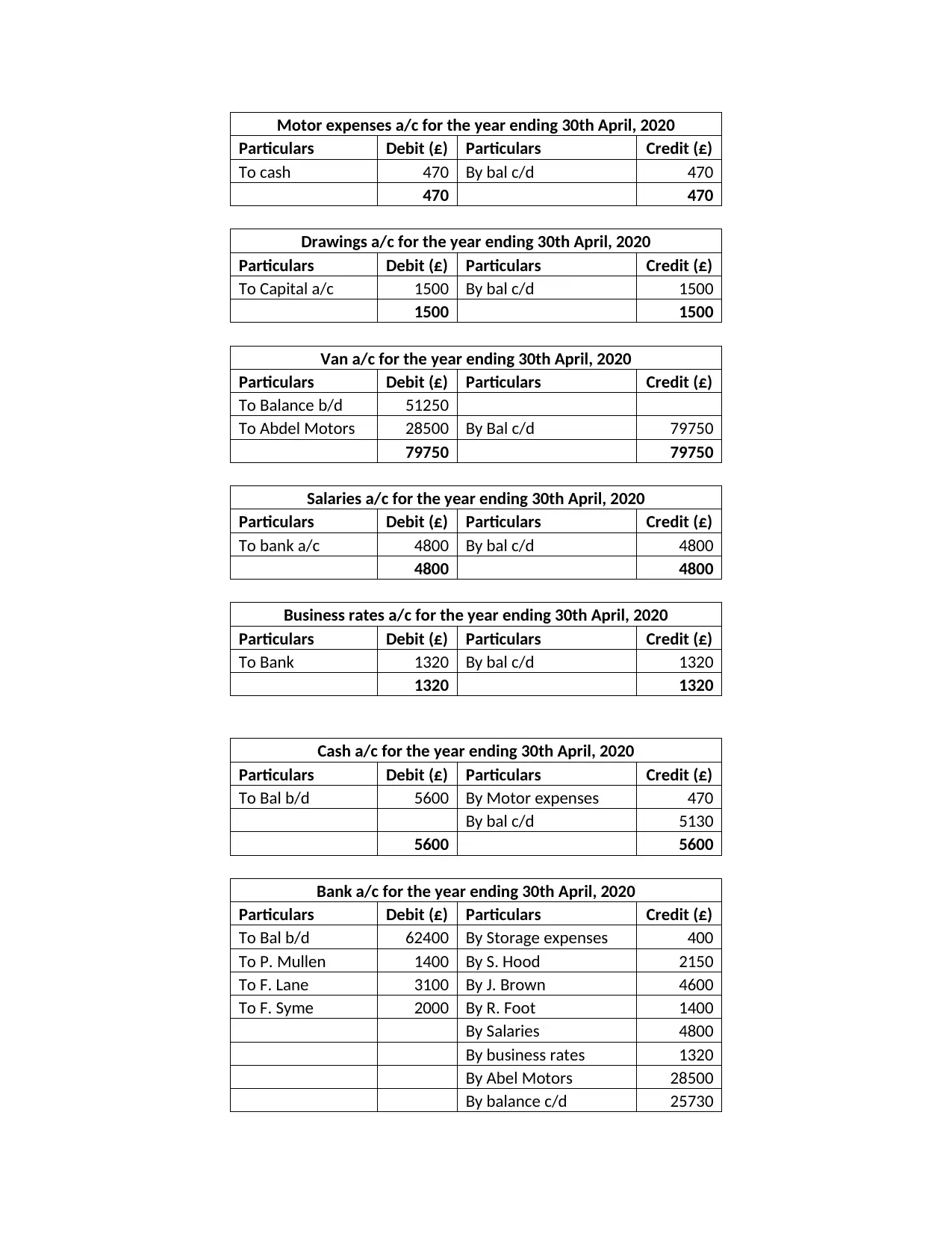
Motor expenses a/c for the year ending 30th April, 2020
Particulars Debit (£) Particulars Credit (£)
To cash 470 By bal c/d 470
470 470
Drawings a/c for the year ending 30th April, 2020
Particulars Debit (£) Particulars Credit (£)
To Capital a/c 1500 By bal c/d 1500
1500 1500
Van a/c for the year ending 30th April, 2020
Particulars Debit (£) Particulars Credit (£)
To Balance b/d 51250
To Abdel Motors 28500 By Bal c/d 79750
79750 79750
Salaries a/c for the year ending 30th April, 2020
Particulars Debit (£) Particulars Credit (£)
To bank a/c 4800 By bal c/d 4800
4800 4800
Business rates a/c for the year ending 30th April, 2020
Particulars Debit (£) Particulars Credit (£)
To Bank 1320 By bal c/d 1320
1320 1320
Cash a/c for the year ending 30th April, 2020
Particulars Debit (£) Particulars Credit (£)
To Bal b/d 5600 By Motor expenses 470
By bal c/d 5130
5600 5600
Bank a/c for the year ending 30th April, 2020
Particulars Debit (£) Particulars Credit (£)
To Bal b/d 62400 By Storage expenses 400
To P. Mullen 1400 By S. Hood 2150
To F. Lane 3100 By J. Brown 4600
To F. Syme 2000 By R. Foot 1400
By Salaries 4800
By business rates 1320
By Abel Motors 28500
By balance c/d 25730
Particulars Debit (£) Particulars Credit (£)
To cash 470 By bal c/d 470
470 470
Drawings a/c for the year ending 30th April, 2020
Particulars Debit (£) Particulars Credit (£)
To Capital a/c 1500 By bal c/d 1500
1500 1500
Van a/c for the year ending 30th April, 2020
Particulars Debit (£) Particulars Credit (£)
To Balance b/d 51250
To Abdel Motors 28500 By Bal c/d 79750
79750 79750
Salaries a/c for the year ending 30th April, 2020
Particulars Debit (£) Particulars Credit (£)
To bank a/c 4800 By bal c/d 4800
4800 4800
Business rates a/c for the year ending 30th April, 2020
Particulars Debit (£) Particulars Credit (£)
To Bank 1320 By bal c/d 1320
1320 1320
Cash a/c for the year ending 30th April, 2020
Particulars Debit (£) Particulars Credit (£)
To Bal b/d 5600 By Motor expenses 470
By bal c/d 5130
5600 5600
Bank a/c for the year ending 30th April, 2020
Particulars Debit (£) Particulars Credit (£)
To Bal b/d 62400 By Storage expenses 400
To P. Mullen 1400 By S. Hood 2150
To F. Lane 3100 By J. Brown 4600
To F. Syme 2000 By R. Foot 1400
By Salaries 4800
By business rates 1320
By Abel Motors 28500
By balance c/d 25730
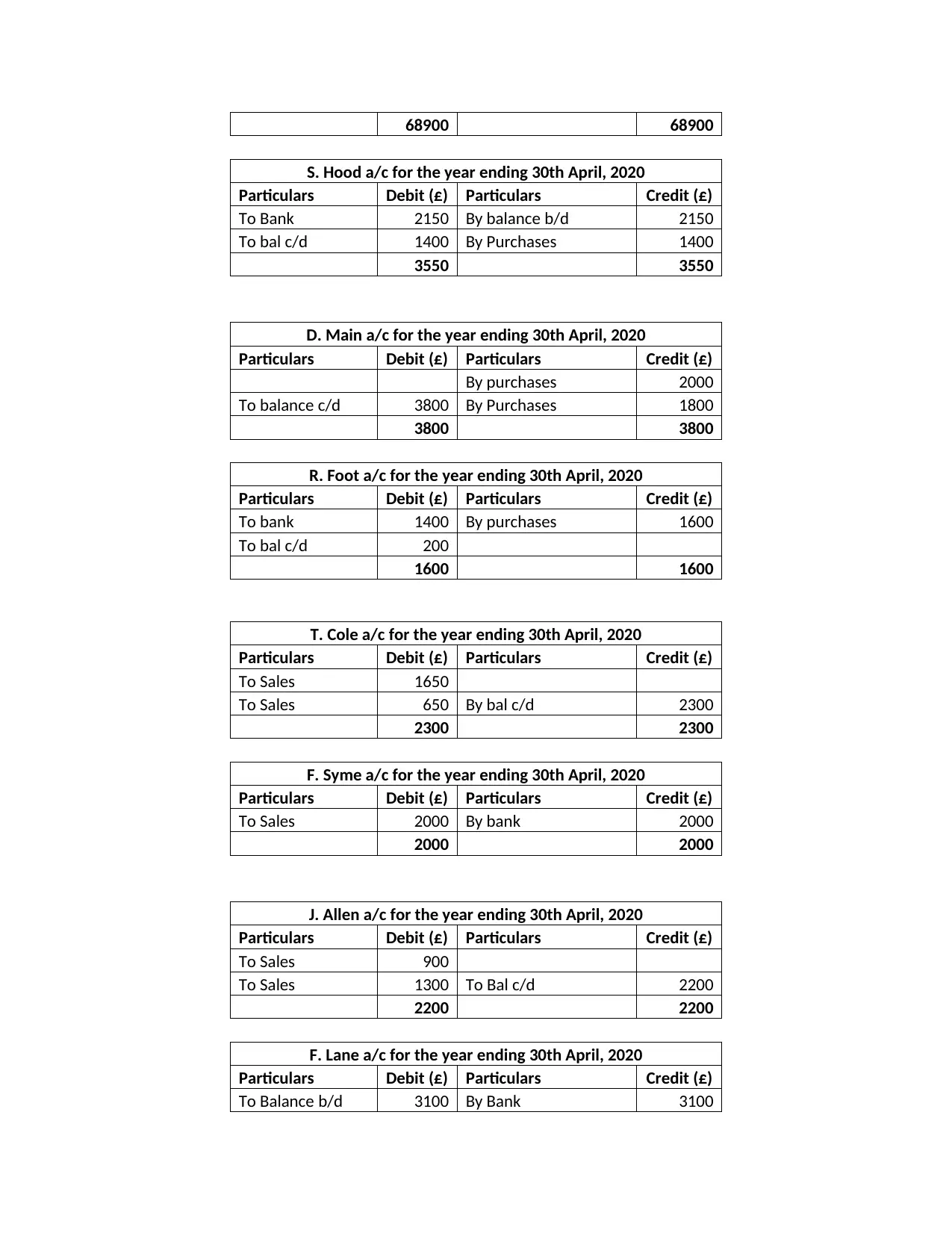
68900 68900
S. Hood a/c for the year ending 30th April, 2020
Particulars Debit (£) Particulars Credit (£)
To Bank 2150 By balance b/d 2150
To bal c/d 1400 By Purchases 1400
3550 3550
D. Main a/c for the year ending 30th April, 2020
Particulars Debit (£) Particulars Credit (£)
By purchases 2000
To balance c/d 3800 By Purchases 1800
3800 3800
R. Foot a/c for the year ending 30th April, 2020
Particulars Debit (£) Particulars Credit (£)
To bank 1400 By purchases 1600
To bal c/d 200
1600 1600
T. Cole a/c for the year ending 30th April, 2020
Particulars Debit (£) Particulars Credit (£)
To Sales 1650
To Sales 650 By bal c/d 2300
2300 2300
F. Syme a/c for the year ending 30th April, 2020
Particulars Debit (£) Particulars Credit (£)
To Sales 2000 By bank 2000
2000 2000
J. Allen a/c for the year ending 30th April, 2020
Particulars Debit (£) Particulars Credit (£)
To Sales 900
To Sales 1300 To Bal c/d 2200
2200 2200
F. Lane a/c for the year ending 30th April, 2020
Particulars Debit (£) Particulars Credit (£)
To Balance b/d 3100 By Bank 3100
S. Hood a/c for the year ending 30th April, 2020
Particulars Debit (£) Particulars Credit (£)
To Bank 2150 By balance b/d 2150
To bal c/d 1400 By Purchases 1400
3550 3550
D. Main a/c for the year ending 30th April, 2020
Particulars Debit (£) Particulars Credit (£)
By purchases 2000
To balance c/d 3800 By Purchases 1800
3800 3800
R. Foot a/c for the year ending 30th April, 2020
Particulars Debit (£) Particulars Credit (£)
To bank 1400 By purchases 1600
To bal c/d 200
1600 1600
T. Cole a/c for the year ending 30th April, 2020
Particulars Debit (£) Particulars Credit (£)
To Sales 1650
To Sales 650 By bal c/d 2300
2300 2300
F. Syme a/c for the year ending 30th April, 2020
Particulars Debit (£) Particulars Credit (£)
To Sales 2000 By bank 2000
2000 2000
J. Allen a/c for the year ending 30th April, 2020
Particulars Debit (£) Particulars Credit (£)
To Sales 900
To Sales 1300 To Bal c/d 2200
2200 2200
F. Lane a/c for the year ending 30th April, 2020
Particulars Debit (£) Particulars Credit (£)
To Balance b/d 3100 By Bank 3100
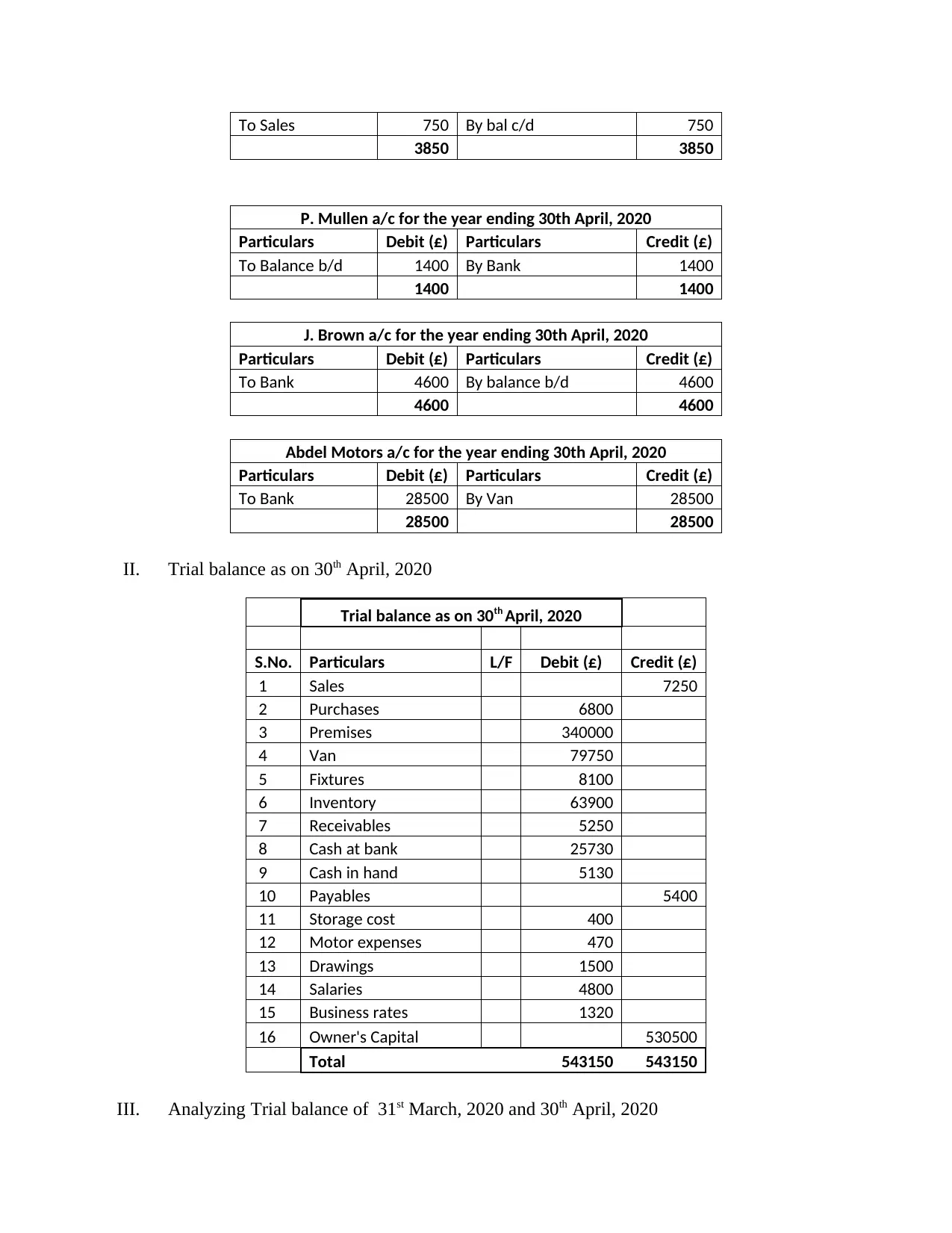
To Sales 750 By bal c/d 750
3850 3850
P. Mullen a/c for the year ending 30th April, 2020
Particulars Debit (£) Particulars Credit (£)
To Balance b/d 1400 By Bank 1400
1400 1400
J. Brown a/c for the year ending 30th April, 2020
Particulars Debit (£) Particulars Credit (£)
To Bank 4600 By balance b/d 4600
4600 4600
Abdel Motors a/c for the year ending 30th April, 2020
Particulars Debit (£) Particulars Credit (£)
To Bank 28500 By Van 28500
28500 28500
II. Trial balance as on 30th April, 2020
Trial balance as on 30th April, 2020
S.No. Particulars L/F Debit (£) Credit (£)
1 Sales 7250
2 Purchases 6800
3 Premises 340000
4 Van 79750
5 Fixtures 8100
6 Inventory 63900
7 Receivables 5250
8 Cash at bank 25730
9 Cash in hand 5130
10 Payables 5400
11 Storage cost 400
12 Motor expenses 470
13 Drawings 1500
14 Salaries 4800
15 Business rates 1320
16 Owner's Capital 530500
Total 543150 543150
III. Analyzing Trial balance of 31st March, 2020 and 30th April, 2020
3850 3850
P. Mullen a/c for the year ending 30th April, 2020
Particulars Debit (£) Particulars Credit (£)
To Balance b/d 1400 By Bank 1400
1400 1400
J. Brown a/c for the year ending 30th April, 2020
Particulars Debit (£) Particulars Credit (£)
To Bank 4600 By balance b/d 4600
4600 4600
Abdel Motors a/c for the year ending 30th April, 2020
Particulars Debit (£) Particulars Credit (£)
To Bank 28500 By Van 28500
28500 28500
II. Trial balance as on 30th April, 2020
Trial balance as on 30th April, 2020
S.No. Particulars L/F Debit (£) Credit (£)
1 Sales 7250
2 Purchases 6800
3 Premises 340000
4 Van 79750
5 Fixtures 8100
6 Inventory 63900
7 Receivables 5250
8 Cash at bank 25730
9 Cash in hand 5130
10 Payables 5400
11 Storage cost 400
12 Motor expenses 470
13 Drawings 1500
14 Salaries 4800
15 Business rates 1320
16 Owner's Capital 530500
Total 543150 543150
III. Analyzing Trial balance of 31st March, 2020 and 30th April, 2020
Paraphrase This Document
Need a fresh take? Get an instant paraphrase of this document with our AI Paraphraser
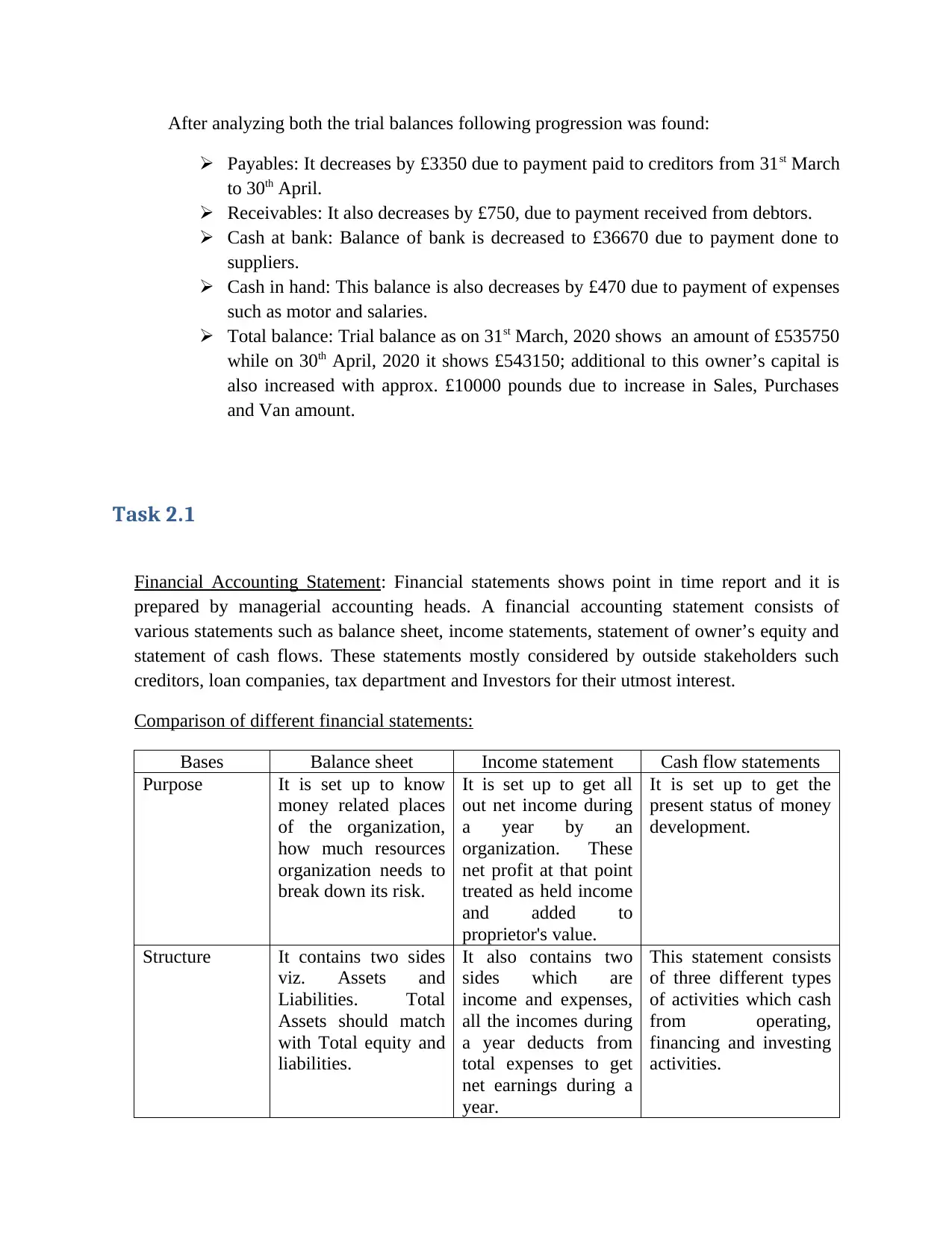
After analyzing both the trial balances following progression was found:
Payables: It decreases by £3350 due to payment paid to creditors from 31st March
to 30th April.
Receivables: It also decreases by £750, due to payment received from debtors.
Cash at bank: Balance of bank is decreased to £36670 due to payment done to
suppliers.
Cash in hand: This balance is also decreases by £470 due to payment of expenses
such as motor and salaries.
Total balance: Trial balance as on 31st March, 2020 shows an amount of £535750
while on 30th April, 2020 it shows £543150; additional to this owner’s capital is
also increased with approx. £10000 pounds due to increase in Sales, Purchases
and Van amount.
Task 2.1
Financial Accounting Statement: Financial statements shows point in time report and it is
prepared by managerial accounting heads. A financial accounting statement consists of
various statements such as balance sheet, income statements, statement of owner’s equity and
statement of cash flows. These statements mostly considered by outside stakeholders such
creditors, loan companies, tax department and Investors for their utmost interest.
Comparison of different financial statements:
Bases Balance sheet Income statement Cash flow statements
Purpose It is set up to know
money related places
of the organization,
how much resources
organization needs to
break down its risk.
It is set up to get all
out net income during
a year by an
organization. These
net profit at that point
treated as held income
and added to
proprietor's value.
It is set up to get the
present status of money
development.
Structure It contains two sides
viz. Assets and
Liabilities. Total
Assets should match
with Total equity and
liabilities.
It also contains two
sides which are
income and expenses,
all the incomes during
a year deducts from
total expenses to get
net earnings during a
year.
This statement consists
of three different types
of activities which cash
from operating,
financing and investing
activities.
Payables: It decreases by £3350 due to payment paid to creditors from 31st March
to 30th April.
Receivables: It also decreases by £750, due to payment received from debtors.
Cash at bank: Balance of bank is decreased to £36670 due to payment done to
suppliers.
Cash in hand: This balance is also decreases by £470 due to payment of expenses
such as motor and salaries.
Total balance: Trial balance as on 31st March, 2020 shows an amount of £535750
while on 30th April, 2020 it shows £543150; additional to this owner’s capital is
also increased with approx. £10000 pounds due to increase in Sales, Purchases
and Van amount.
Task 2.1
Financial Accounting Statement: Financial statements shows point in time report and it is
prepared by managerial accounting heads. A financial accounting statement consists of
various statements such as balance sheet, income statements, statement of owner’s equity and
statement of cash flows. These statements mostly considered by outside stakeholders such
creditors, loan companies, tax department and Investors for their utmost interest.
Comparison of different financial statements:
Bases Balance sheet Income statement Cash flow statements
Purpose It is set up to know
money related places
of the organization,
how much resources
organization needs to
break down its risk.
It is set up to get all
out net income during
a year by an
organization. These
net profit at that point
treated as held income
and added to
proprietor's value.
It is set up to get the
present status of money
development.
Structure It contains two sides
viz. Assets and
Liabilities. Total
Assets should match
with Total equity and
liabilities.
It also contains two
sides which are
income and expenses,
all the incomes during
a year deducts from
total expenses to get
net earnings during a
year.
This statement consists
of three different types
of activities which cash
from operating,
financing and investing
activities.

Content Asset sides contains
two types of assets;
non- current assets
which are not
acquired for resale or
taking more than a
year to convert into
cash. Current Assets
these are convertible
into cash less than a
year.
Liabilities also
divided into three
parts; equity shares,
capital and retained
earnings if any. Non
current liabilities are
long term loans and
current liabilities are
short term
outstanding.
This statement
consists of Income
and expenses which
includes all the
incomes expenses
from trading,
operating and selling
activities. Net
earnings gained are
further reduced to get
net incomes after
paying taxes and
interest.
It only considers cash
transactions, all non
cash expenses added
back to net earnings and
all incomes deduct from
the same to get real net
cash from operating
activities. Investment
activities consist all
selling and buying of
fixed assets in cash.
Financial activities
records only issued of
shares and dividend
paid transactions.
Task 2.2
Income statement of Italian Wine limited for the year ending 31st March, 2020:
Profit and loss a/c for the year ended 31st March, 2020
Particulars
L/
f
Debit
(£)
Credit
(£)
Sales revenue 198000
Opening Inventory 12000
Purchases 102000
Closing Inventory 14000
Gross profit 98000
Salaries and wages 5500
add accrued salary 2000
Administrative expenses 24500
Distribution expenses 14000
Dividends paid 1000
Depreciation:
Property 2% 6000
Motor Vehicles 10% 1080
two types of assets;
non- current assets
which are not
acquired for resale or
taking more than a
year to convert into
cash. Current Assets
these are convertible
into cash less than a
year.
Liabilities also
divided into three
parts; equity shares,
capital and retained
earnings if any. Non
current liabilities are
long term loans and
current liabilities are
short term
outstanding.
This statement
consists of Income
and expenses which
includes all the
incomes expenses
from trading,
operating and selling
activities. Net
earnings gained are
further reduced to get
net incomes after
paying taxes and
interest.
It only considers cash
transactions, all non
cash expenses added
back to net earnings and
all incomes deduct from
the same to get real net
cash from operating
activities. Investment
activities consist all
selling and buying of
fixed assets in cash.
Financial activities
records only issued of
shares and dividend
paid transactions.
Task 2.2
Income statement of Italian Wine limited for the year ending 31st March, 2020:
Profit and loss a/c for the year ended 31st March, 2020
Particulars
L/
f
Debit
(£)
Credit
(£)
Sales revenue 198000
Opening Inventory 12000
Purchases 102000
Closing Inventory 14000
Gross profit 98000
Salaries and wages 5500
add accrued salary 2000
Administrative expenses 24500
Distribution expenses 14000
Dividends paid 1000
Depreciation:
Property 2% 6000
Motor Vehicles 10% 1080
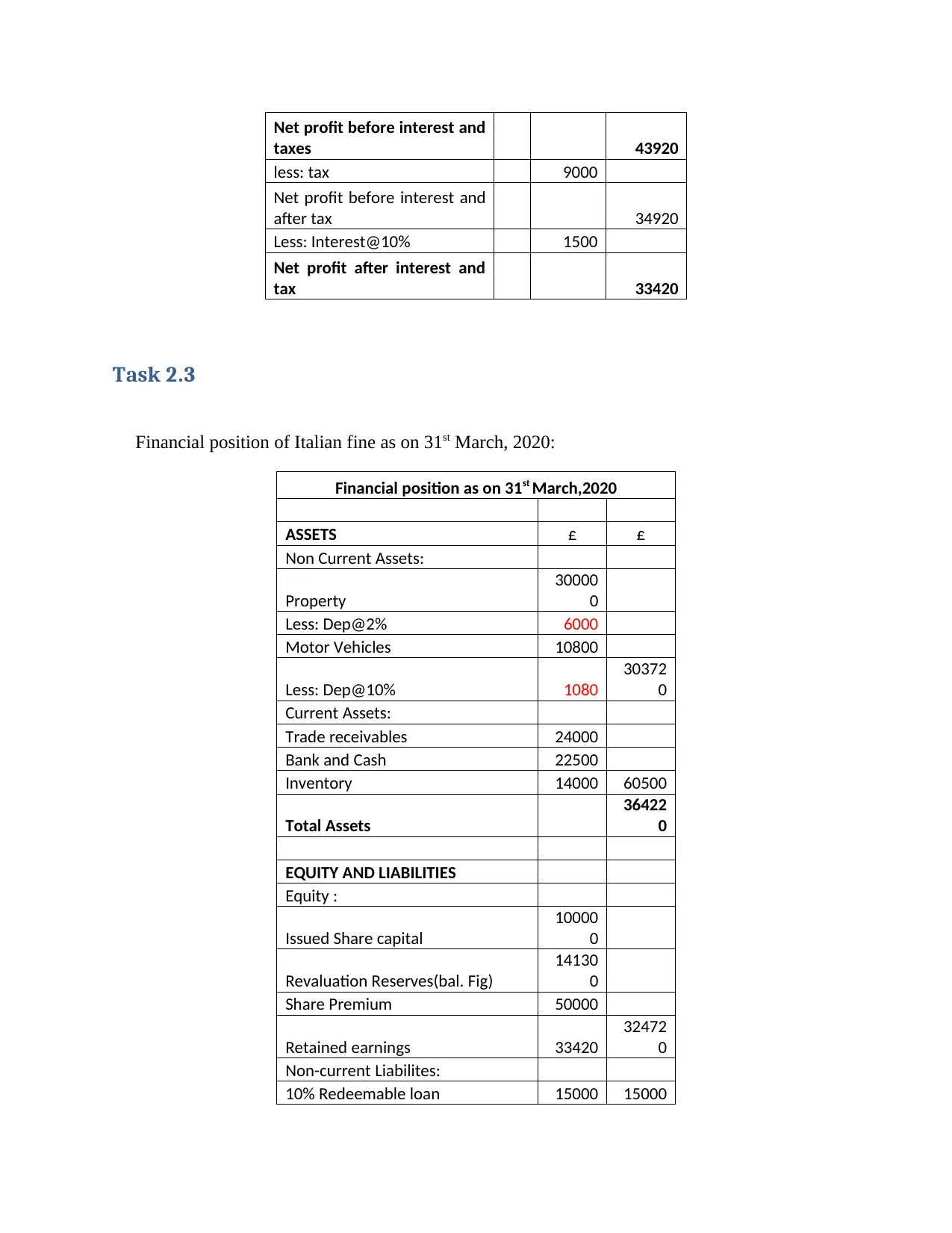
Net profit before interest and
taxes 43920
less: tax 9000
Net profit before interest and
after tax 34920
Less: Interest@10% 1500
Net profit after interest and
tax 33420
Task 2.3
Financial position of Italian fine as on 31st March, 2020:
Financial position as on 31st March,2020
ASSETS £ £
Non Current Assets:
Property
30000
0
Less: Dep@2% 6000
Motor Vehicles 10800
Less: Dep@10% 1080
30372
0
Current Assets:
Trade receivables 24000
Bank and Cash 22500
Inventory 14000 60500
Total Assets
36422
0
EQUITY AND LIABILITIES
Equity :
Issued Share capital
10000
0
Revaluation Reserves(bal. Fig)
14130
0
Share Premium 50000
Retained earnings 33420
32472
0
Non-current Liabilites:
10% Redeemable loan 15000 15000
taxes 43920
less: tax 9000
Net profit before interest and
after tax 34920
Less: Interest@10% 1500
Net profit after interest and
tax 33420
Task 2.3
Financial position of Italian fine as on 31st March, 2020:
Financial position as on 31st March,2020
ASSETS £ £
Non Current Assets:
Property
30000
0
Less: Dep@2% 6000
Motor Vehicles 10800
Less: Dep@10% 1080
30372
0
Current Assets:
Trade receivables 24000
Bank and Cash 22500
Inventory 14000 60500
Total Assets
36422
0
EQUITY AND LIABILITIES
Equity :
Issued Share capital
10000
0
Revaluation Reserves(bal. Fig)
14130
0
Share Premium 50000
Retained earnings 33420
32472
0
Non-current Liabilites:
10% Redeemable loan 15000 15000
Secure Best Marks with AI Grader
Need help grading? Try our AI Grader for instant feedback on your assignments.
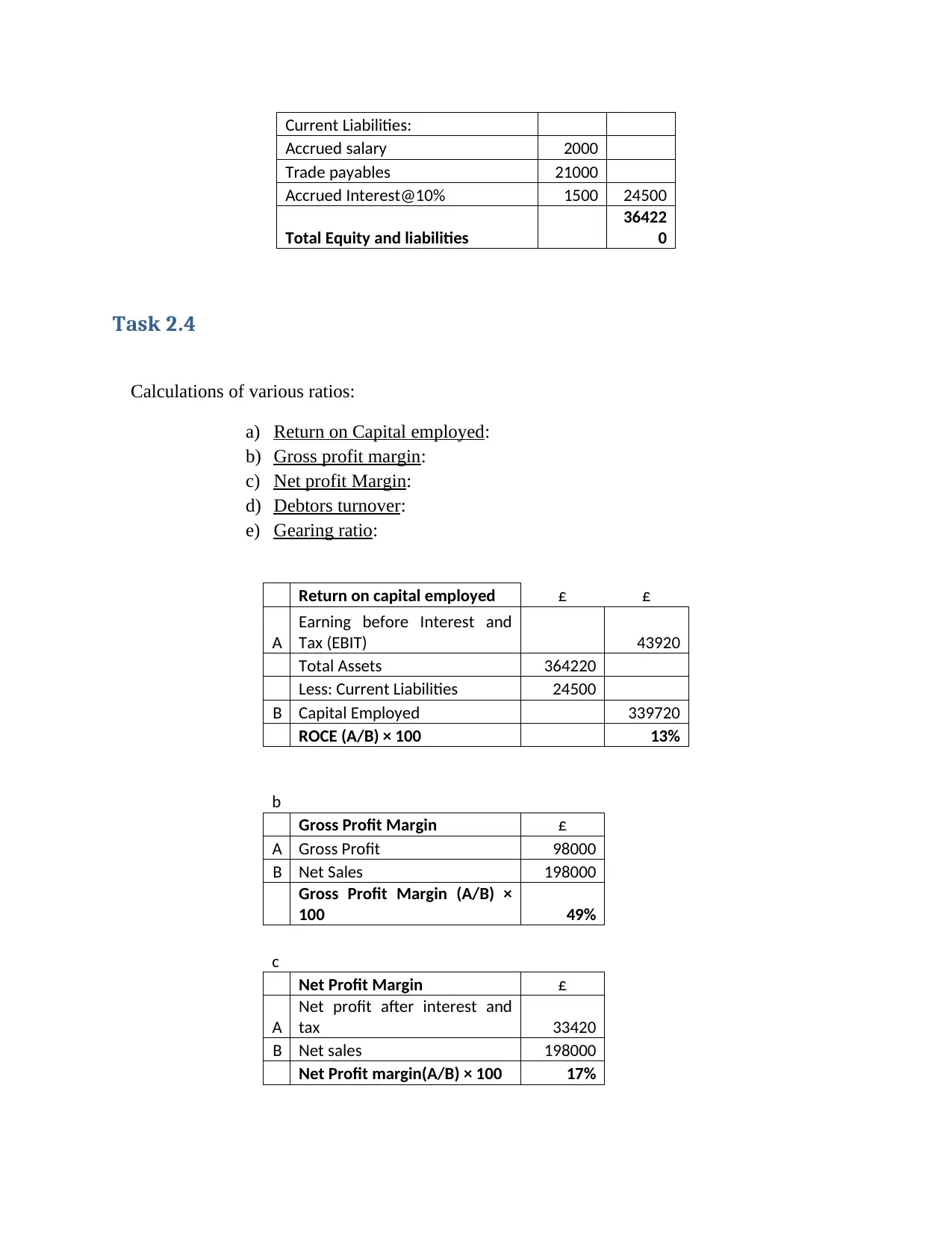
Current Liabilities:
Accrued salary 2000
Trade payables 21000
Accrued Interest@10% 1500 24500
Total Equity and liabilities
36422
0
Task 2.4
Calculations of various ratios:
a) Return on Capital employed:
b) Gross profit margin:
c) Net profit Margin:
d) Debtors turnover:
e) Gearing ratio:
Return on capital employed £ £
A
Earning before Interest and
Tax (EBIT) 43920
Total Assets 364220
Less: Current Liabilities 24500
B Capital Employed 339720
ROCE (A/B) × 100 13%
b
Gross Profit Margin £
A Gross Profit 98000
B Net Sales 198000
Gross Profit Margin (A/B) ×
100 49%
c
Net Profit Margin £
A
Net profit after interest and
tax 33420
B Net sales 198000
Net Profit margin(A/B) × 100 17%
Accrued salary 2000
Trade payables 21000
Accrued Interest@10% 1500 24500
Total Equity and liabilities
36422
0
Task 2.4
Calculations of various ratios:
a) Return on Capital employed:
b) Gross profit margin:
c) Net profit Margin:
d) Debtors turnover:
e) Gearing ratio:
Return on capital employed £ £
A
Earning before Interest and
Tax (EBIT) 43920
Total Assets 364220
Less: Current Liabilities 24500
B Capital Employed 339720
ROCE (A/B) × 100 13%
b
Gross Profit Margin £
A Gross Profit 98000
B Net Sales 198000
Gross Profit Margin (A/B) ×
100 49%
c
Net Profit Margin £
A
Net profit after interest and
tax 33420
B Net sales 198000
Net Profit margin(A/B) × 100 17%
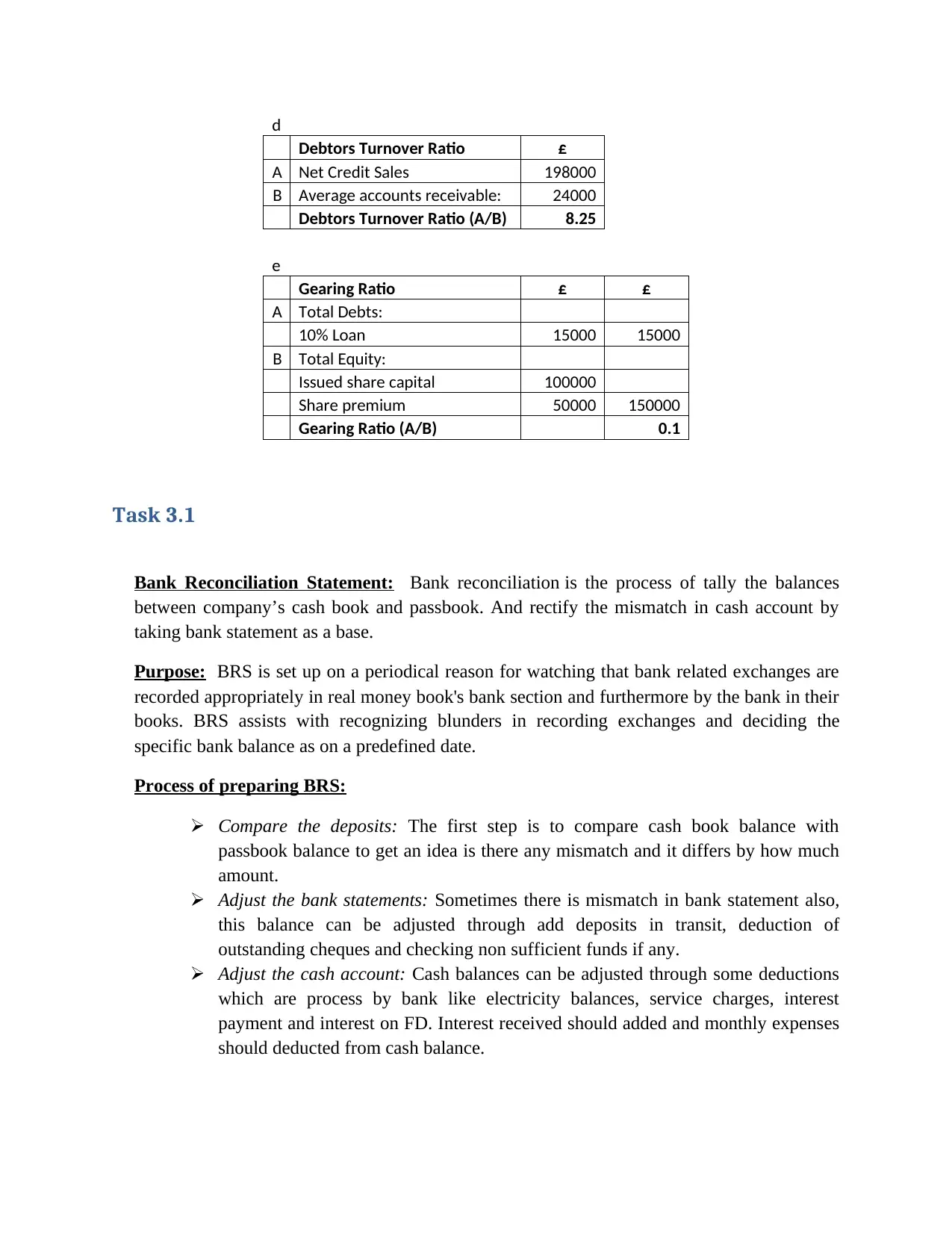
d
Debtors Turnover Ratio £
A Net Credit Sales 198000
B Average accounts receivable: 24000
Debtors Turnover Ratio (A/B) 8.25
e
Gearing Ratio £ £
A Total Debts:
10% Loan 15000 15000
B Total Equity:
Issued share capital 100000
Share premium 50000 150000
Gearing Ratio (A/B) 0.1
Task 3.1
Bank Reconciliation Statement: Bank reconciliation is the process of tally the balances
between company’s cash book and passbook. And rectify the mismatch in cash account by
taking bank statement as a base.
Purpose: BRS is set up on a periodical reason for watching that bank related exchanges are
recorded appropriately in real money book's bank section and furthermore by the bank in their
books. BRS assists with recognizing blunders in recording exchanges and deciding the
specific bank balance as on a predefined date.
Process of preparing BRS:
Compare the deposits: The first step is to compare cash book balance with
passbook balance to get an idea is there any mismatch and it differs by how much
amount.
Adjust the bank statements: Sometimes there is mismatch in bank statement also,
this balance can be adjusted through add deposits in transit, deduction of
outstanding cheques and checking non sufficient funds if any.
Adjust the cash account: Cash balances can be adjusted through some deductions
which are process by bank like electricity balances, service charges, interest
payment and interest on FD. Interest received should added and monthly expenses
should deducted from cash balance.
Debtors Turnover Ratio £
A Net Credit Sales 198000
B Average accounts receivable: 24000
Debtors Turnover Ratio (A/B) 8.25
e
Gearing Ratio £ £
A Total Debts:
10% Loan 15000 15000
B Total Equity:
Issued share capital 100000
Share premium 50000 150000
Gearing Ratio (A/B) 0.1
Task 3.1
Bank Reconciliation Statement: Bank reconciliation is the process of tally the balances
between company’s cash book and passbook. And rectify the mismatch in cash account by
taking bank statement as a base.
Purpose: BRS is set up on a periodical reason for watching that bank related exchanges are
recorded appropriately in real money book's bank section and furthermore by the bank in their
books. BRS assists with recognizing blunders in recording exchanges and deciding the
specific bank balance as on a predefined date.
Process of preparing BRS:
Compare the deposits: The first step is to compare cash book balance with
passbook balance to get an idea is there any mismatch and it differs by how much
amount.
Adjust the bank statements: Sometimes there is mismatch in bank statement also,
this balance can be adjusted through add deposits in transit, deduction of
outstanding cheques and checking non sufficient funds if any.
Adjust the cash account: Cash balances can be adjusted through some deductions
which are process by bank like electricity balances, service charges, interest
payment and interest on FD. Interest received should added and monthly expenses
should deducted from cash balance.
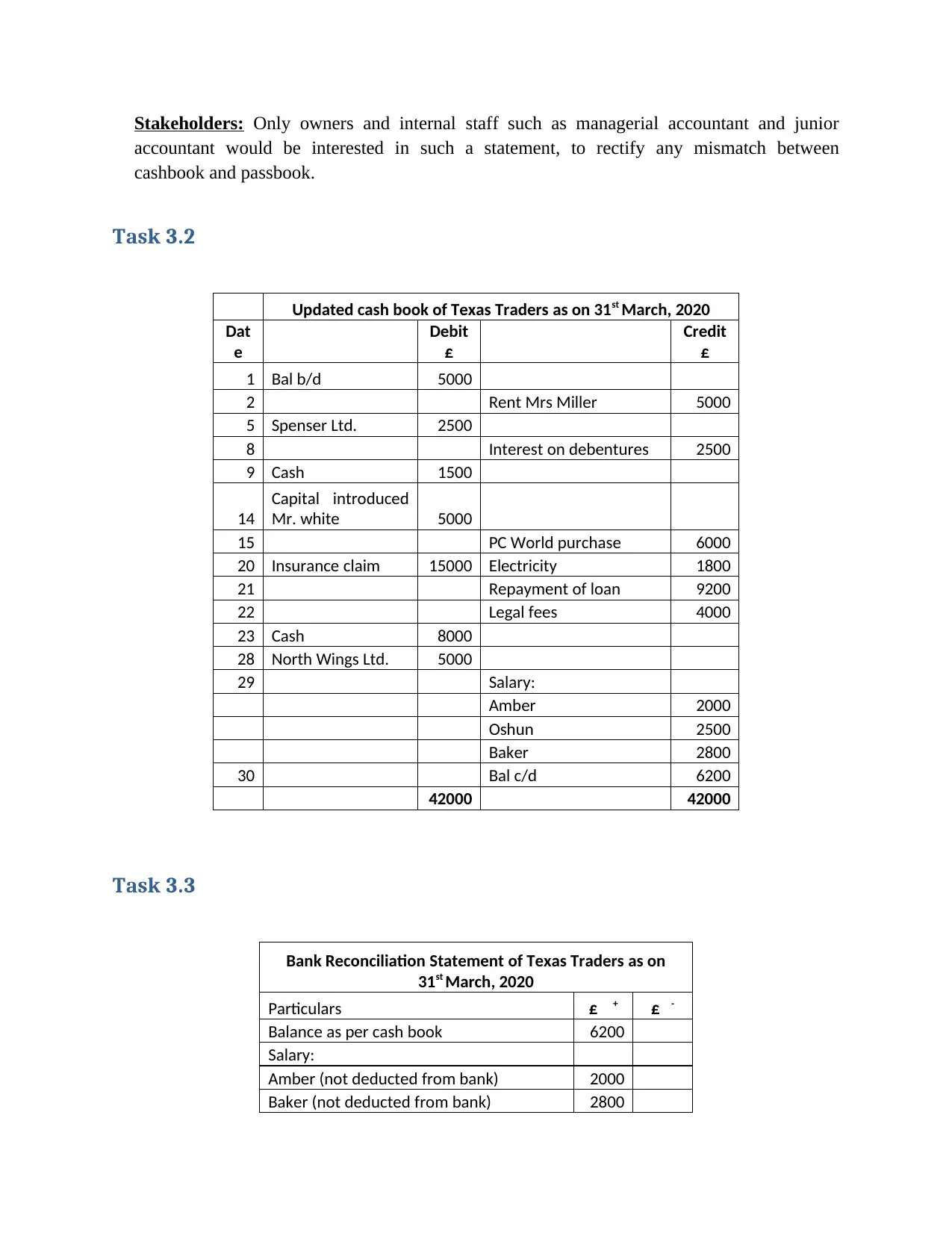
Stakeholders: Only owners and internal staff such as managerial accountant and junior
accountant would be interested in such a statement, to rectify any mismatch between
cashbook and passbook.
Task 3.2
Updated cash book of Texas Traders as on 31st March, 2020
Dat
e
Debit
£
Credit
£
1 Bal b/d 5000
2 Rent Mrs Miller 5000
5 Spenser Ltd. 2500
8 Interest on debentures 2500
9 Cash 1500
14
Capital introduced
Mr. white 5000
15 PC World purchase 6000
20 Insurance claim 15000 Electricity 1800
21 Repayment of loan 9200
22 Legal fees 4000
23 Cash 8000
28 North Wings Ltd. 5000
29 Salary:
Amber 2000
Oshun 2500
Baker 2800
30 Bal c/d 6200
42000 42000
Task 3.3
Bank Reconciliation Statement of Texas Traders as on
31st March, 2020
Particulars £ + £ -
Balance as per cash book 6200
Salary:
Amber (not deducted from bank) 2000
Baker (not deducted from bank) 2800
accountant would be interested in such a statement, to rectify any mismatch between
cashbook and passbook.
Task 3.2
Updated cash book of Texas Traders as on 31st March, 2020
Dat
e
Debit
£
Credit
£
1 Bal b/d 5000
2 Rent Mrs Miller 5000
5 Spenser Ltd. 2500
8 Interest on debentures 2500
9 Cash 1500
14
Capital introduced
Mr. white 5000
15 PC World purchase 6000
20 Insurance claim 15000 Electricity 1800
21 Repayment of loan 9200
22 Legal fees 4000
23 Cash 8000
28 North Wings Ltd. 5000
29 Salary:
Amber 2000
Oshun 2500
Baker 2800
30 Bal c/d 6200
42000 42000
Task 3.3
Bank Reconciliation Statement of Texas Traders as on
31st March, 2020
Particulars £ + £ -
Balance as per cash book 6200
Salary:
Amber (not deducted from bank) 2000
Baker (not deducted from bank) 2800
Paraphrase This Document
Need a fresh take? Get an instant paraphrase of this document with our AI Paraphraser
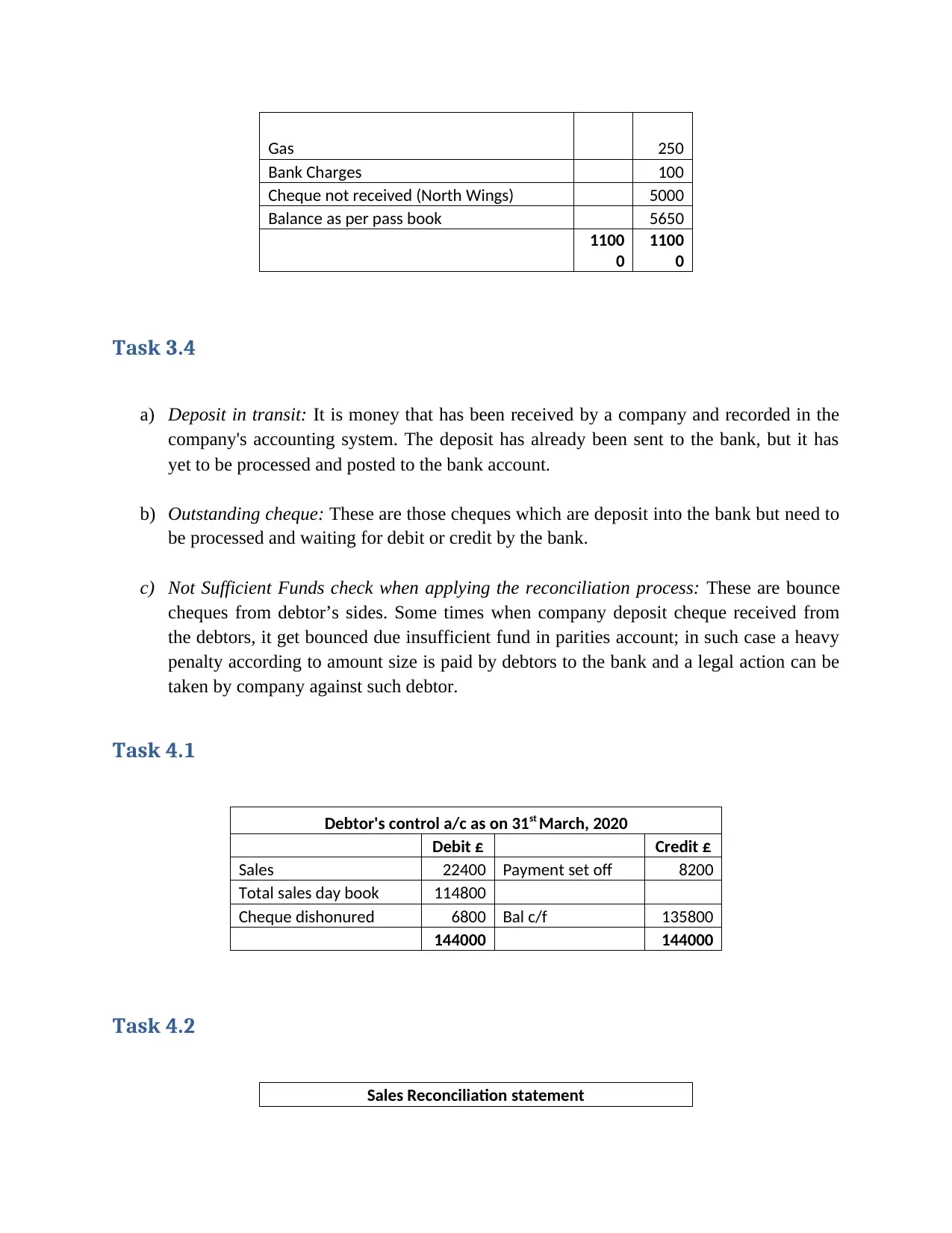
Gas 250
Bank Charges 100
Cheque not received (North Wings) 5000
Balance as per pass book 5650
1100
0
1100
0
Task 3.4
a) Deposit in transit: It is money that has been received by a company and recorded in the
company's accounting system. The deposit has already been sent to the bank, but it has
yet to be processed and posted to the bank account.
b) Outstanding cheque: These are those cheques which are deposit into the bank but need to
be processed and waiting for debit or credit by the bank.
c) Not Sufficient Funds check when applying the reconciliation process: These are bounce
cheques from debtor’s sides. Some times when company deposit cheque received from
the debtors, it get bounced due insufficient fund in parities account; in such case a heavy
penalty according to amount size is paid by debtors to the bank and a legal action can be
taken by company against such debtor.
Task 4.1
Debtor's control a/c as on 31st March, 2020
Debit £ Credit £
Sales 22400 Payment set off 8200
Total sales day book 114800
Cheque dishonured 6800 Bal c/f 135800
144000 144000
Task 4.2
Sales Reconciliation statement
Bank Charges 100
Cheque not received (North Wings) 5000
Balance as per pass book 5650
1100
0
1100
0
Task 3.4
a) Deposit in transit: It is money that has been received by a company and recorded in the
company's accounting system. The deposit has already been sent to the bank, but it has
yet to be processed and posted to the bank account.
b) Outstanding cheque: These are those cheques which are deposit into the bank but need to
be processed and waiting for debit or credit by the bank.
c) Not Sufficient Funds check when applying the reconciliation process: These are bounce
cheques from debtor’s sides. Some times when company deposit cheque received from
the debtors, it get bounced due insufficient fund in parities account; in such case a heavy
penalty according to amount size is paid by debtors to the bank and a legal action can be
taken by company against such debtor.
Task 4.1
Debtor's control a/c as on 31st March, 2020
Debit £ Credit £
Sales 22400 Payment set off 8200
Total sales day book 114800
Cheque dishonured 6800 Bal c/f 135800
144000 144000
Task 4.2
Sales Reconciliation statement
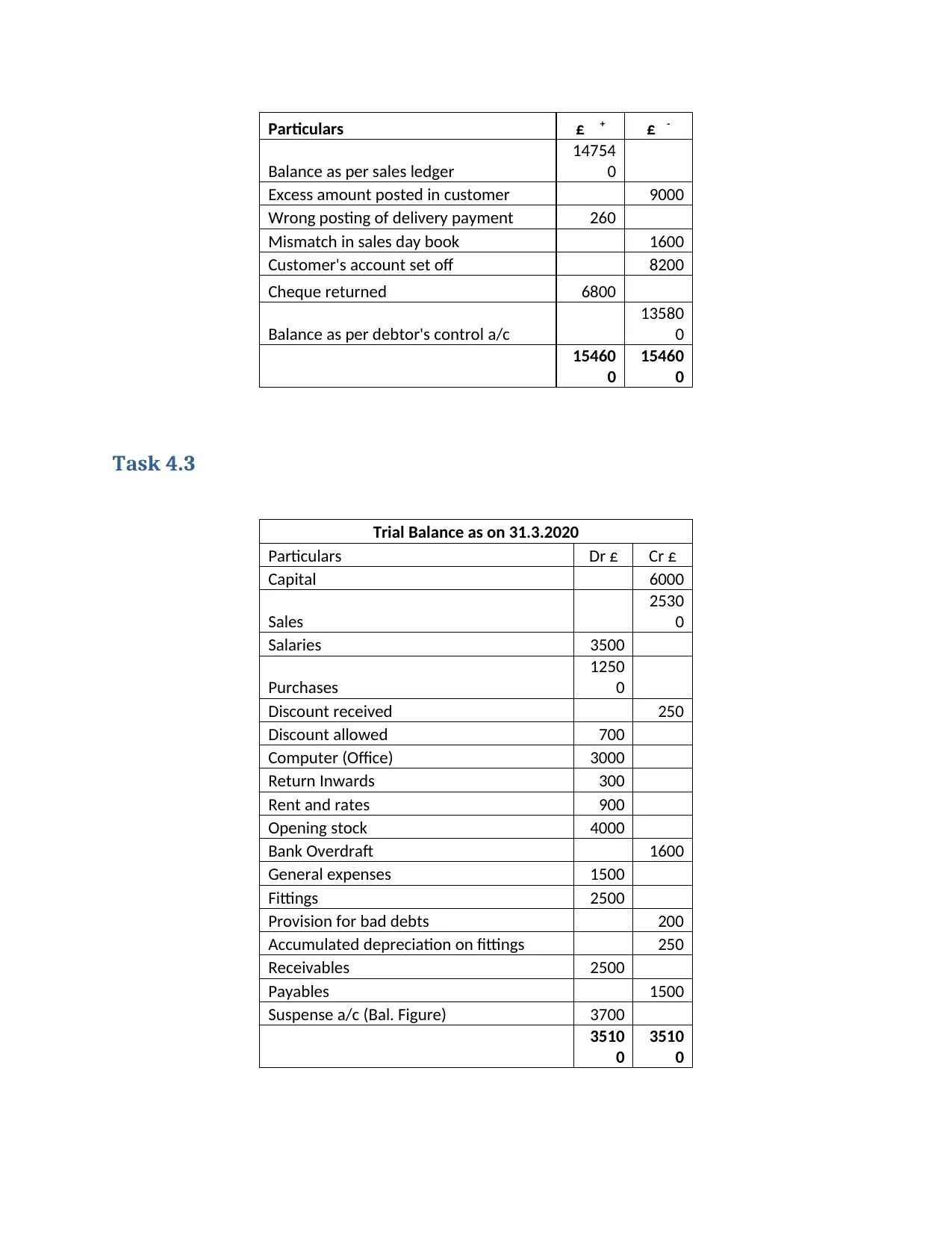
Particulars £ + £ -
Balance as per sales ledger
14754
0
Excess amount posted in customer 9000
Wrong posting of delivery payment 260
Mismatch in sales day book 1600
Customer's account set off 8200
Cheque returned 6800
Balance as per debtor's control a/c
13580
0
15460
0
15460
0
Task 4.3
Trial Balance as on 31.3.2020
Particulars Dr £ Cr £
Capital 6000
Sales
2530
0
Salaries 3500
Purchases
1250
0
Discount received 250
Discount allowed 700
Computer (Office) 3000
Return Inwards 300
Rent and rates 900
Opening stock 4000
Bank Overdraft 1600
General expenses 1500
Fittings 2500
Provision for bad debts 200
Accumulated depreciation on fittings 250
Receivables 2500
Payables 1500
Suspense a/c (Bal. Figure) 3700
3510
0
3510
0
Balance as per sales ledger
14754
0
Excess amount posted in customer 9000
Wrong posting of delivery payment 260
Mismatch in sales day book 1600
Customer's account set off 8200
Cheque returned 6800
Balance as per debtor's control a/c
13580
0
15460
0
15460
0
Task 4.3
Trial Balance as on 31.3.2020
Particulars Dr £ Cr £
Capital 6000
Sales
2530
0
Salaries 3500
Purchases
1250
0
Discount received 250
Discount allowed 700
Computer (Office) 3000
Return Inwards 300
Rent and rates 900
Opening stock 4000
Bank Overdraft 1600
General expenses 1500
Fittings 2500
Provision for bad debts 200
Accumulated depreciation on fittings 250
Receivables 2500
Payables 1500
Suspense a/c (Bal. Figure) 3700
3510
0
3510
0
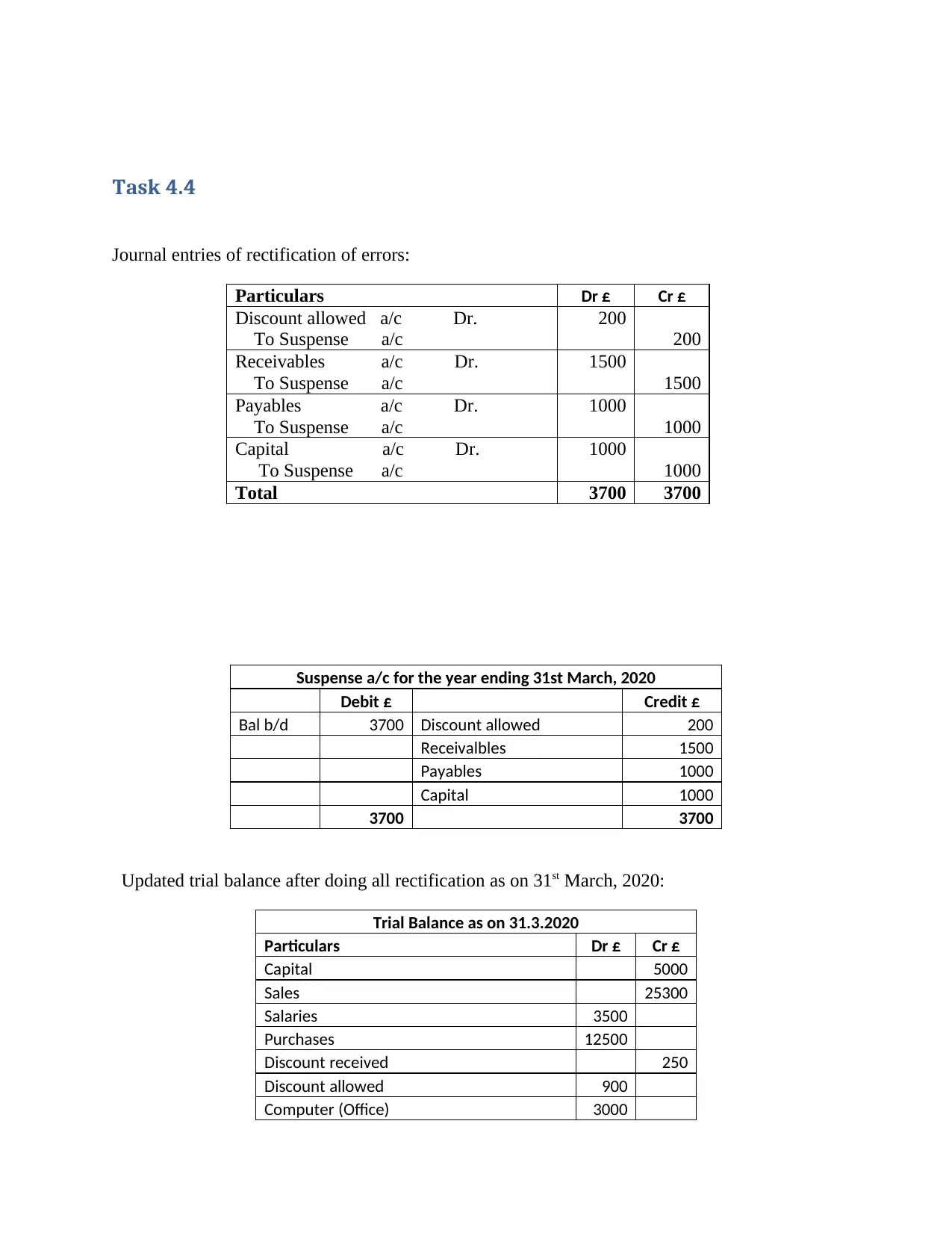
Task 4.4
Journal entries of rectification of errors:
Particulars Dr £ Cr £
Discount allowed a/c Dr.
To Suspense a/c
200
200
Receivables a/c Dr.
To Suspense a/c
1500
1500
Payables a/c Dr.
To Suspense a/c
1000
1000
Capital a/c Dr.
To Suspense a/c
1000
1000
Total 3700 3700
Suspense a/c for the year ending 31st March, 2020
Debit £ Credit £
Bal b/d 3700 Discount allowed 200
Receivalbles 1500
Payables 1000
Capital 1000
3700 3700
Updated trial balance after doing all rectification as on 31st March, 2020:
Trial Balance as on 31.3.2020
Particulars Dr £ Cr £
Capital 5000
Sales 25300
Salaries 3500
Purchases 12500
Discount received 250
Discount allowed 900
Computer (Office) 3000
Journal entries of rectification of errors:
Particulars Dr £ Cr £
Discount allowed a/c Dr.
To Suspense a/c
200
200
Receivables a/c Dr.
To Suspense a/c
1500
1500
Payables a/c Dr.
To Suspense a/c
1000
1000
Capital a/c Dr.
To Suspense a/c
1000
1000
Total 3700 3700
Suspense a/c for the year ending 31st March, 2020
Debit £ Credit £
Bal b/d 3700 Discount allowed 200
Receivalbles 1500
Payables 1000
Capital 1000
3700 3700
Updated trial balance after doing all rectification as on 31st March, 2020:
Trial Balance as on 31.3.2020
Particulars Dr £ Cr £
Capital 5000
Sales 25300
Salaries 3500
Purchases 12500
Discount received 250
Discount allowed 900
Computer (Office) 3000
Secure Best Marks with AI Grader
Need help grading? Try our AI Grader for instant feedback on your assignments.
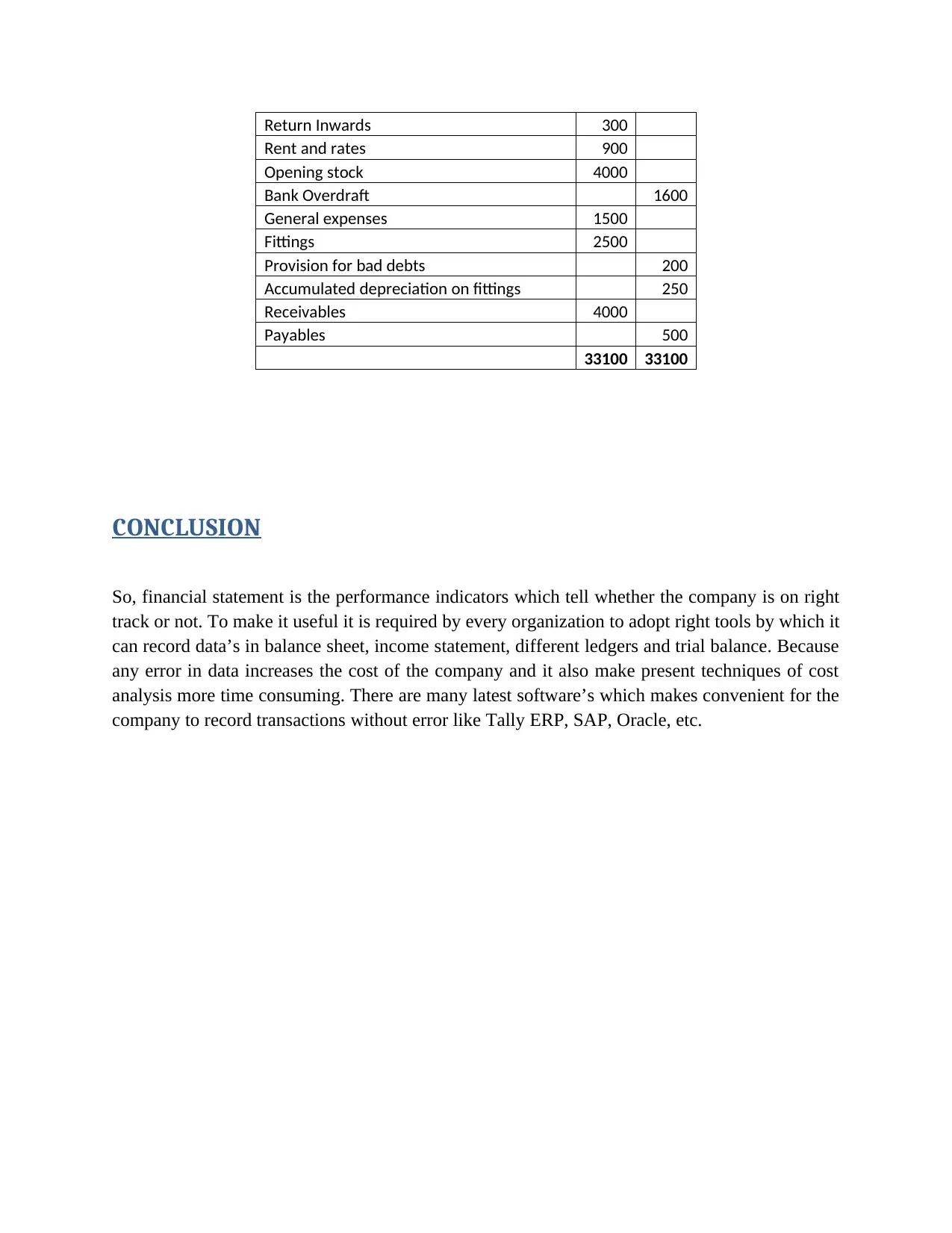
Return Inwards 300
Rent and rates 900
Opening stock 4000
Bank Overdraft 1600
General expenses 1500
Fittings 2500
Provision for bad debts 200
Accumulated depreciation on fittings 250
Receivables 4000
Payables 500
33100 33100
CONCLUSION
So, financial statement is the performance indicators which tell whether the company is on right
track or not. To make it useful it is required by every organization to adopt right tools by which it
can record data’s in balance sheet, income statement, different ledgers and trial balance. Because
any error in data increases the cost of the company and it also make present techniques of cost
analysis more time consuming. There are many latest software’s which makes convenient for the
company to record transactions without error like Tally ERP, SAP, Oracle, etc.
Rent and rates 900
Opening stock 4000
Bank Overdraft 1600
General expenses 1500
Fittings 2500
Provision for bad debts 200
Accumulated depreciation on fittings 250
Receivables 4000
Payables 500
33100 33100
CONCLUSION
So, financial statement is the performance indicators which tell whether the company is on right
track or not. To make it useful it is required by every organization to adopt right tools by which it
can record data’s in balance sheet, income statement, different ledgers and trial balance. Because
any error in data increases the cost of the company and it also make present techniques of cost
analysis more time consuming. There are many latest software’s which makes convenient for the
company to record transactions without error like Tally ERP, SAP, Oracle, etc.
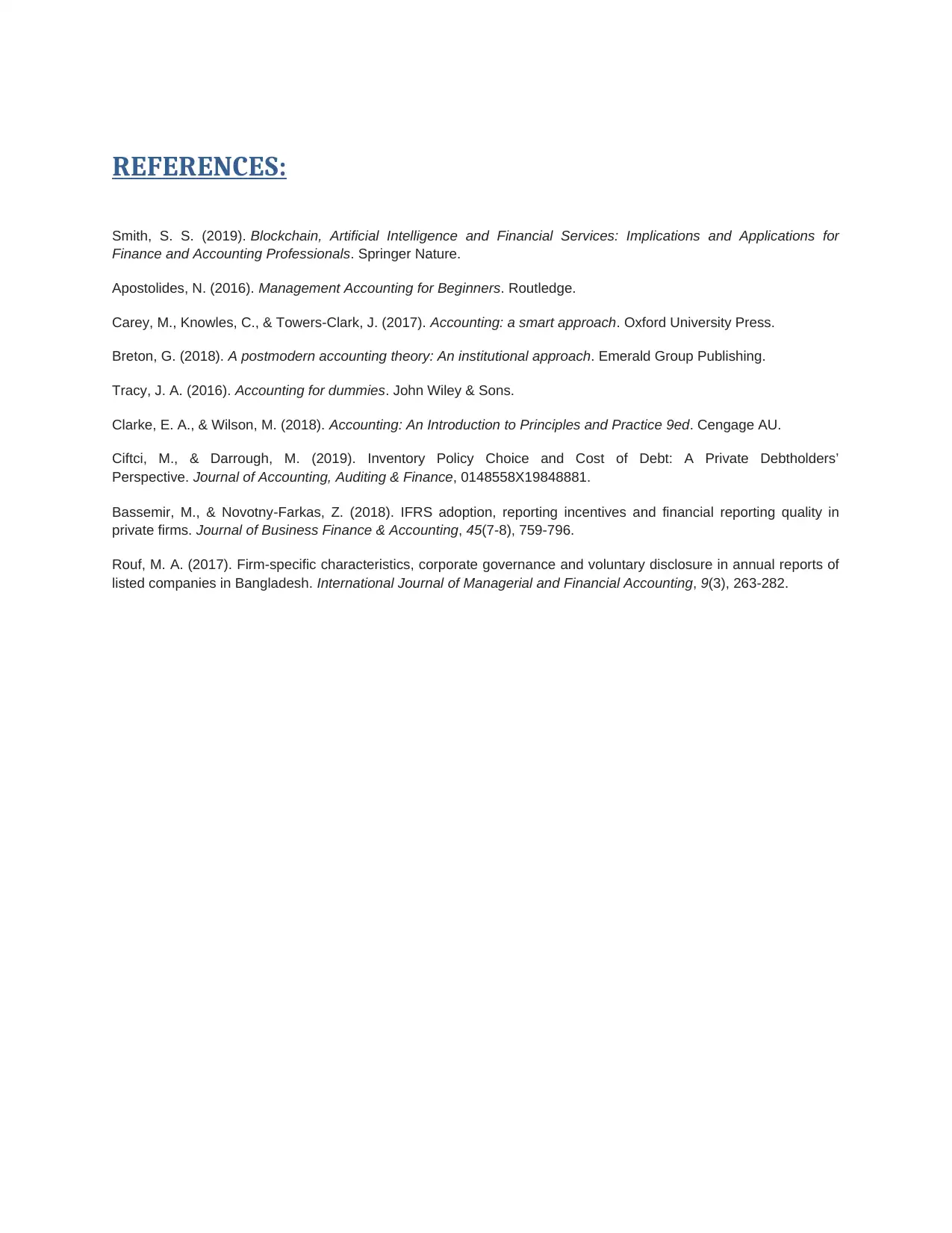
REFERENCES:
Smith, S. S. (2019). Blockchain, Artificial Intelligence and Financial Services: Implications and Applications for
Finance and Accounting Professionals. Springer Nature.
Apostolides, N. (2016). Management Accounting for Beginners. Routledge.
Carey, M., Knowles, C., & Towers-Clark, J. (2017). Accounting: a smart approach. Oxford University Press.
Breton, G. (2018). A postmodern accounting theory: An institutional approach. Emerald Group Publishing.
Tracy, J. A. (2016). Accounting for dummies. John Wiley & Sons.
Clarke, E. A., & Wilson, M. (2018). Accounting: An Introduction to Principles and Practice 9ed. Cengage AU.
Ciftci, M., & Darrough, M. (2019). Inventory Policy Choice and Cost of Debt: A Private Debtholders’
Perspective. Journal of Accounting, Auditing & Finance, 0148558X19848881.
Bassemir, M., & Novotny‐Farkas, Z. (2018). IFRS adoption, reporting incentives and financial reporting quality in
private firms. Journal of Business Finance & Accounting, 45(7-8), 759-796.
Rouf, M. A. (2017). Firm-specific characteristics, corporate governance and voluntary disclosure in annual reports of
listed companies in Bangladesh. International Journal of Managerial and Financial Accounting, 9(3), 263-282.
Smith, S. S. (2019). Blockchain, Artificial Intelligence and Financial Services: Implications and Applications for
Finance and Accounting Professionals. Springer Nature.
Apostolides, N. (2016). Management Accounting for Beginners. Routledge.
Carey, M., Knowles, C., & Towers-Clark, J. (2017). Accounting: a smart approach. Oxford University Press.
Breton, G. (2018). A postmodern accounting theory: An institutional approach. Emerald Group Publishing.
Tracy, J. A. (2016). Accounting for dummies. John Wiley & Sons.
Clarke, E. A., & Wilson, M. (2018). Accounting: An Introduction to Principles and Practice 9ed. Cengage AU.
Ciftci, M., & Darrough, M. (2019). Inventory Policy Choice and Cost of Debt: A Private Debtholders’
Perspective. Journal of Accounting, Auditing & Finance, 0148558X19848881.
Bassemir, M., & Novotny‐Farkas, Z. (2018). IFRS adoption, reporting incentives and financial reporting quality in
private firms. Journal of Business Finance & Accounting, 45(7-8), 759-796.
Rouf, M. A. (2017). Firm-specific characteristics, corporate governance and voluntary disclosure in annual reports of
listed companies in Bangladesh. International Journal of Managerial and Financial Accounting, 9(3), 263-282.
1 out of 18
Your All-in-One AI-Powered Toolkit for Academic Success.
+13062052269
info@desklib.com
Available 24*7 on WhatsApp / Email
![[object Object]](/_next/static/media/star-bottom.7253800d.svg)
Unlock your academic potential
© 2024 | Zucol Services PVT LTD | All rights reserved.




